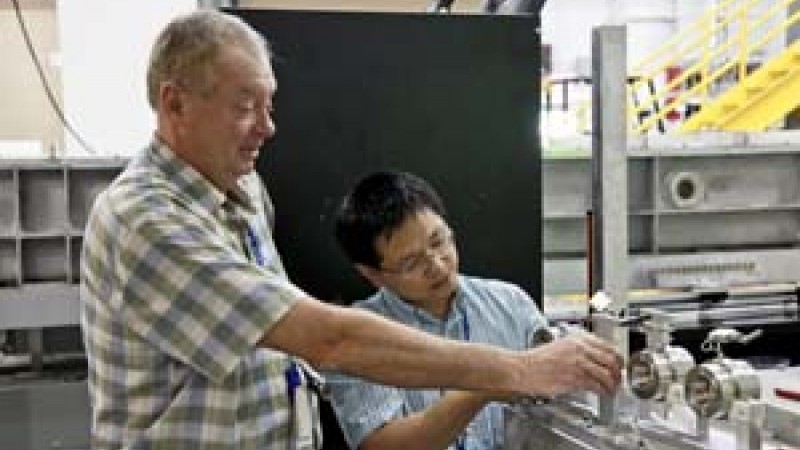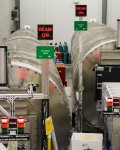When you heat water in a kettle, you can make tea or coffee. But what happens if the vessel is sealed? Ultimately, at a temperature called the liquid-gas critical point, the density of the liquid and the vapor become identical: There is no more water, there is no more gas. What you have is a supercritical fluid.
The phenomenon of liquid-liquid and liquid-gas coexistence was a fundamental problem that was solved at the end of the last century, says Yuri Melnichenko (born in Kiev, Ukraine), instrument scientist for the General-Purpose Small-Angle Neutron Scattering (GP-SANS) Diffractometer at ORNL's High Flux Isotope Reactor.
“When we understood this very specific behavior of bulk fluids near their critical points, (e.g., water in a kettle is a bulk system), then the natural question is how does this behavior, this coexistence, change if you confine the whole system in a very small space, such as a small pore, say, in coal.”
“If you start to decrease the size down to the nanometer (billionths of a meter), the interactions between the molecules and the walls of the pores become increasingly important. They change the behavior of the confined fluid dramatically.”
The behavior of a confined fluid then becomes dependent on pore size, pore shape, the specifics of the molecule-surface interactions, etc. “So this is a huge problem. There is a big matrix of a great number of different parameters that may influence behavior of a fluid in small pores.”
This problem has become increasingly important, as the U.S. Department of Energy looks for ways to cope with America’s greenhouse gases. Despite all we now know, 50 to 60% of energy in the United States is still generated from coal-burning plants. One option to get rid of the unwanted greenhouse gases, such as carbon dioxide (CO2), is to sequester them long-term in coal seams that are so deep underground they are inaccessible to mining. In such deep seams, temperature and pressure are so high that CO2 becomes supercritical.
At the same time, there are billions of tons of natural gas in the United States, mostly methane confined underground in shale and coal, ready to be used if it can be efficiently extracted.
And beyond CO2 storage and methane recovery, other porous matrices figure in other fields of science and technology such as separations, pollution abatement, and catalysis and catalysis supports. There are numerous applications for such technology in the chemical, petrochemical, gas processing, and pharmaceutical industries.
”So we have a very beautiful fundamental problem about how confinement in small pores affects the phase behavior of fluids. And we have very good potential applications,” Melnichenko says.
“But what happens to the CO2 molecules when you pump them into the coal? I was very surprised when I started talking to geologists. Nobody knew what would be an optimal seam depth for sequestration How much CO2 would coal uptake? Will it get physically or chemically transformed with time? Nobody knew.”
Melnichenko, his postdoctoral associate Lilin He (from Sichuan, China), and his collaborators are working on these and related problems. They are currently issuing a flurry of new research papers from the GP-SANS instrument describing studies of confined fluids in very small pores, from the sub-nanometer (Ångstrom, or tenths of billionths of a meter) to the micron (millionths of a meter).
“I think we were the first to apply small-angle neutron scattering to study adsorption in confined supercritical fluids,” Melnichenko said. “When you inject such a fluid into a porous system, the SANS lets you observe a strong adsorption. A few molecules become strongly bound to the surface, and then the extent of this binding goes into the pore. It is very important to understand how many of the molecules get bound, get adsorbed. What are the physical properties of that bound layer? What is the physical density? What is the volume of that adsorbed fluid? How do pores of different size contribute to the adsorption phenomenon?”
“SANS is ideally suited because of the resolution. You can use it to look into very small, sub-nanometer–sized pores. Then with ultra-small-angle neutron scattering (USANS), you can monitor the behavior of a fluid in bigger, micron-sized pores.”
Use of the two methods in tandem has produced results of great interest to geologists. In “Accessibility of pores in coal to methane and carbon dioxide,” just published online by the journal FUEL, the researchers report how they resolved the question of whether all pores in coal are accessible to CO2 injection. Geologists had long used conflicting models.
Melnichenko, Lilin He, Arkady Kholodenko (Clemson), and Richard Sakurovs (CSIRO, Australia) developed a new method of data analysis that allows them to correlate the neutron scattering intensity with the volume of closed pores, as a function of pore sizes. This new approach was used to study the accessibility of pores to methane and supercritical CO2 in coals from Indiana (United States) and the Bowen Basin (Australia).
SANS showed that there are indeed pores inaccessible to CO2 and methane. The technique also provided evidence that closed pores exist in all studied coals, with a distinct, “fingerprint” distribution of closed porosity. “This new approach made the geologists really excited,” Melnichenko said. “And we are now running a set of 20 different coals to try to find the correlation―why some coals have more accessible pores and some less. And why some coals have micrometer pores that are less accessible than nanometer pores.”
The researchers have also started to use a combination of quasi-elastic neutron scattering (QENS) and SANS to study how confinement in pores, pore size, and molecule-surface interactions affects the mobility of methane. The question is important for the extraction of methane from coal and shale for use as a fuel. Research on this work, “Effect of carbon dioxide and nitrogen on the diffusivity of methane confined in nano-porous carbon aerogel,” was recently accepted by Microporous and Mesoporous Materials.
Carbon aerogel was chosen as the confinement material, as it mimics coal well, and the research team turned to another ORNL instrument: BASIS, the backscattering spectrometer at the Spallation Neutron Source. “We wanted to reproduce the situation in real coal. That is, if you have methane in pores of the coal and you inject CO2, what happens to the methane? At what pressure and temperature does it get desorbed from the surface? How easy would it be to extract?“
The data showed that the methane molecules were strongly adsorbed to the surface and at ambient temperature had extremely low molecular mobility in nanometer pores of the carbon aerogel. The data can be used to understand the phase behavior, as well as the mobility of methane-CO2 mixtures in real coals, which can improve extraction methods.
Now, the researchers are increasingly combining the two scattering techniques, SANS and QENS, so they can get both the structural information and adsorption parameters (SANS) and the mobility of fluids in pores (QENS). “Having these two techniques in tandem is a very powerful combination for studying both adsorption and mobility. And you can understand the mobility changes better if you have the information about structure and adsorption. So these methods are very strongly interrelated.”
On his desk, Melnichenko rests his elbows on a stack of at least nine more papers, either recently accepted or in press. “We have great collaborations with several groups of geologists from all around the world. The interest for these studies is high, and currently we have more experimental data than we can handle. Looks like this stack won’t get any slimmer in the near future,” he said.
In the end, it comes down to using fundamental science to help geologists do their work in an area that is key to both environmental and energy concerns. “When you study fluids in model porous media that are very well characterized in terms of the pore sizes, shapes, and porosity, you can apply this information to more structurally complex natural systems like coal and shale, and so you help geologists and others in the industry to better use their technology.”
This research was funded by the U.S. Department of Energy (DOE) Office of Basic Energy Sciences.
Published Work
Yuri B. Melnichenko, Lilin He, Richard Sakurovs, Arkady L. Kholodenko, Tomasz Blach, Maria Mastalerz, Andrzej P. Radlińskie, Gang Cheng, David F. R. Mildner, "Accessibility of pores in coal to methane and carbon dioxide," Fuel, j.fuel.2011.06.026 (2011)






